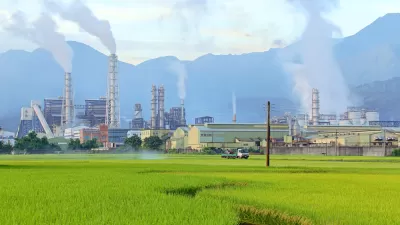According to a new EPA draft assessment, fracking has not caused pollution of drinking water, though concerns are raised. The report has yet to be reviewed by the Science Advisory Board and is now receiving public comment.
Based on the findings of the draft assessment, "the Environmental Protection Agency says it has found no evidence that hydraulic fracturing — better known as fracking — has led to widespread pollution of drinking water," reports Jeff Brady, energy correspondent for National Public Radio.

Credit: EPA: The Hydraulic Fracturing Water Cycle
"We found the hydraulic fracturing activities in the United States are carried out in a way that has not led to widespread systemic impacts on drinking water resources," [italics added] says Tom Burke, science adviser and deputy assistant administrator of the EPA's Office of Research and Development."In fact, the number of documented impacts to drinking water resources is relatively low when compared to the number of fractured wells," he adds.
The report, done at the behest of Congress, "is the most complete compilation of scientific data to date," says Burke, "including over 950 sources of information, published papers, numerous technical reports, information from stakeholders and peer-reviewed EPA scientific reports."
While the preliminary outcome is pleasing to the energy industry, environmentalists, who "have long argued fracking comes with a cost to the environment, especially to water," criticized the findings. In a press release, Food & Water Watch accused the study of having "the industry's oil fingerprints all over it:"
It is outrageous that the oil and gas industry refused to cooperate with the EPA on a single ‘prospective case study.’ This reveals the undue influence the industry has over the government and shows that the industry is afraid to allow careful monitoring of their operations.”
"The American Petroleum Institute says the conclusions echo what the oil industry has argued all along," writes Brady. “After more than five years and millions of dollars, the evidence gathered by EPA confirms what the agency has already acknowledged and what the oil and gas industry has known,” said API Upstream Group Director Erik Milito in their press release.
"The report also raises concerns about wells that are inadequately cased or cemented — something that can allow gases and liquids to migrate below ground," writes Brady. "Another area of vulnerability the EPA highlights in its report is how wastewater and fracking fluids from drilling operations are handled and treated."
Public comment is being accepted via the Federal Register.
Listen to the report here.
FULL STORY: EPA Finds No Widespread Drinking Water Pollution From Fracking

Depopulation Patterns Get Weird
A recent ranking of “declining” cities heavily features some of the most expensive cities in the country — including New York City and a half-dozen in the San Francisco Bay Area.

California Exodus: Population Drops Below 39 Million
Never mind the 40 million that demographers predicted the Golden State would reach by 2018. The state's population dipped below 39 million to 38.965 million last July, according to Census data released in March, the lowest since 2015.

Chicago to Turn High-Rise Offices into Housing
Four commercial buildings in the Chicago Loop have been approved for redevelopment into housing in a bid to revitalize the city’s downtown post-pandemic.

Pennsylvania Mall Conversion Bill Passes House
If passed, the bill would promote the adaptive reuse of defunct commercial buildings.

Meet NYC’s New Office of Livable Streets
The NYC DOT program will build on pandemic-era initiatives to promote safe and comfortable streets that enhance community and expand uses beyond just moving cars.

Transit Riders Face the Highest Safety Risks in These 10 States
According to federal data, the average number of safety incidents on public transportation averaged 55.2 per 100,000 people across all states between 2010 and 2023. Which states came in well above the national average?
City of Costa Mesa
Licking County
Barrett Planning Group LLC
HUD's Office of Policy Development and Research
Mpact Transit + Community
HUD's Office of Policy Development and Research
City of Universal City TX
ULI Northwest Arkansas
Town of Zionsville
Urban Design for Planners 1: Software Tools
This six-course series explores essential urban design concepts using open source software and equips planners with the tools they need to participate fully in the urban design process.
Planning for Universal Design
Learn the tools for implementing Universal Design in planning regulations.





















